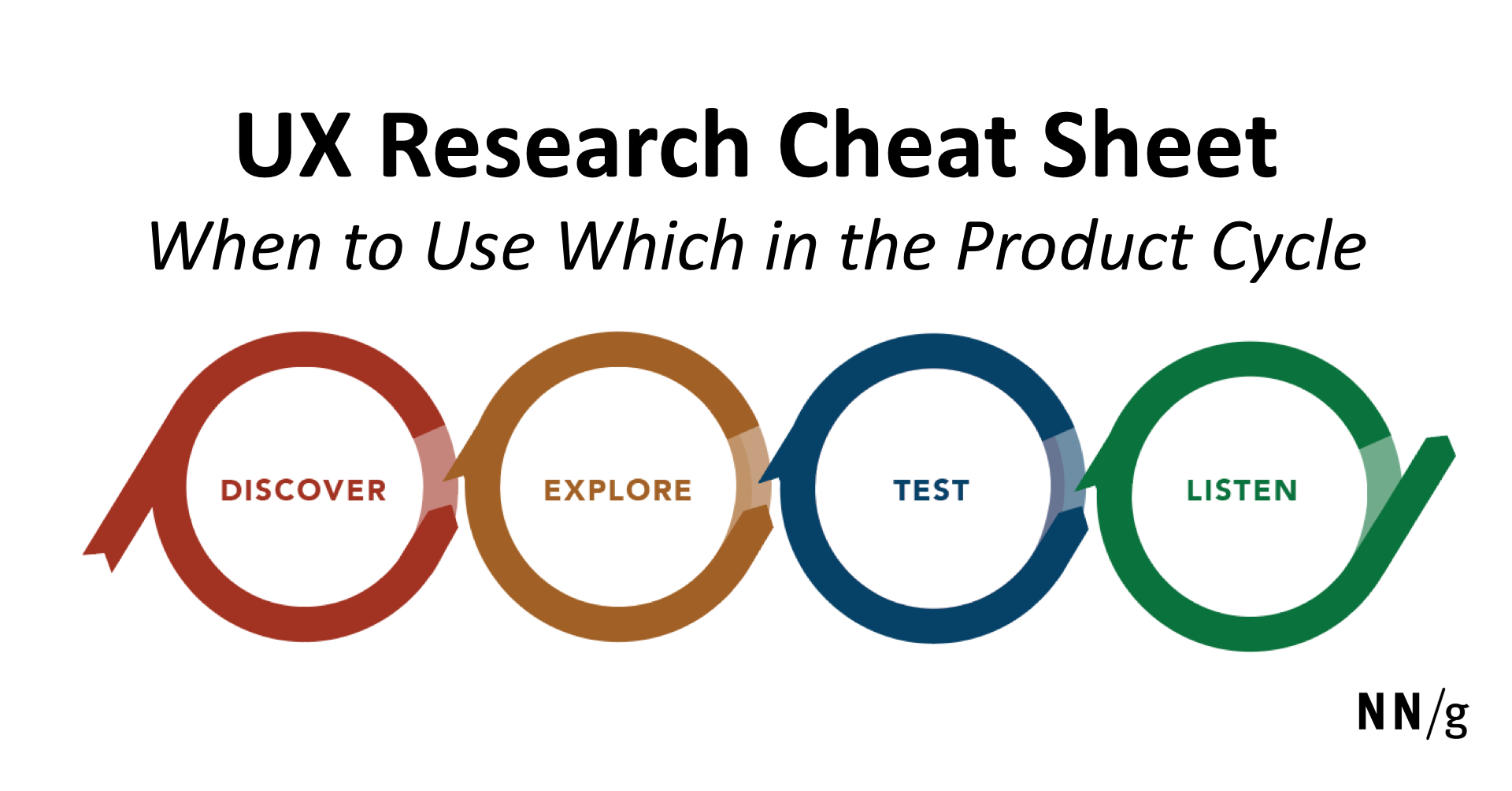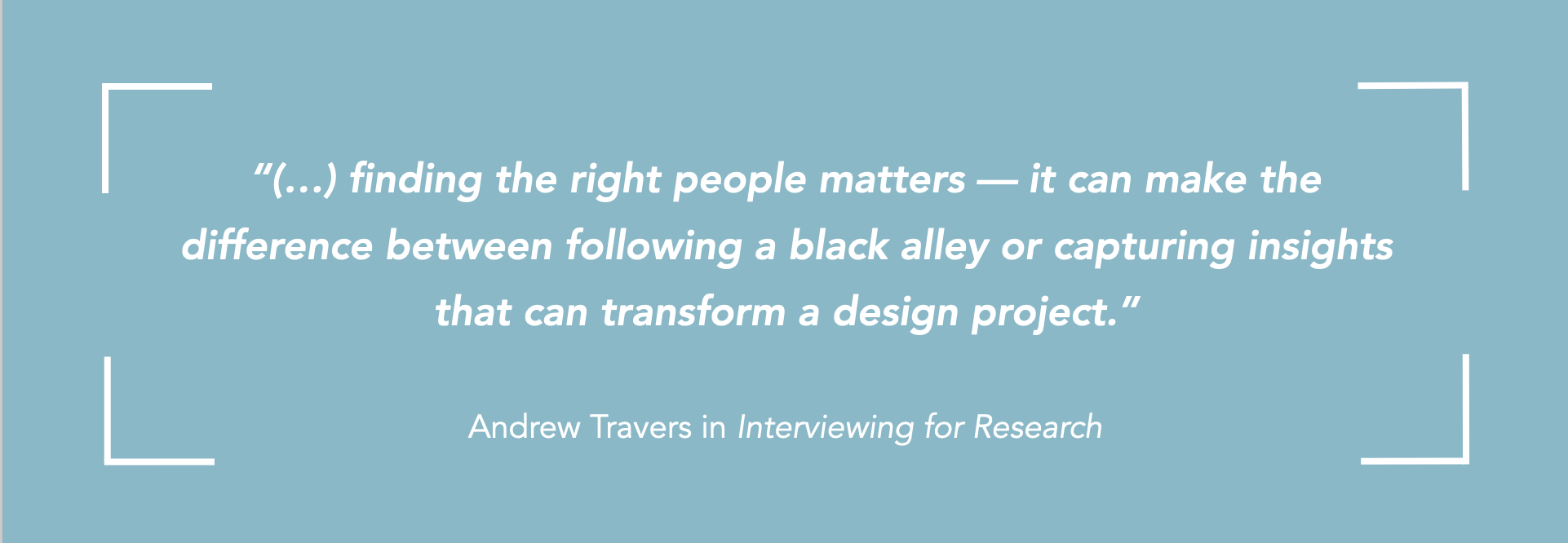
10 Bad User Research Practices You Will Want to Avoid
April 30, 2021Some might think user research is as simple as watching people perform a few tasks on a website or asking them a few questions, but user research is definitely a not walk in the park.
When done right research leads to evidence-based decisions and the design of great services and products. However, there are a lot of ways user research can go wrong that will lead to low-quality data, wrong conclusions and ultimately to the development of a product destined to fail.
Let’s go through some of the mistakes that can arise when planning and conducting research.
1. Setting unclear research objectives
Before you get into timeframes, budgets and recruitment you need to make sure you understand what you want to find out. The “why” of your research. The questions you want to see answered. Objectives will, of course, depend on which stage of the product development you are in — discovery, testing and validating or post-launch.
Good research questions are specific, actionable and practical and very importantly — research questions are not interview questions. They drive the entire research project so they should be written effectively. Let’s take a look at a few examples:
- How do people currently use the favourites feature on our website?
- What actions do our customers take when they’re thinking about buying a new fridge?
Objectives will help you to determine which research method you will need to use to get the answers you need and from then your tasks and interview questions.

2. Choosing the wrong research method
As we’ve seen before, the first question you should ask is — what do you want to know? Do you need to find out who are your users or perhaps how are they using the product? Once you know what you’re trying to learn, you can start thinking about how to get the answers you need.
User research can be done at any stage of the design and development process and there’s a wide range of research methods, the difficulty might be to know which to use and when.
Let’s say you’re in the discovery stage of your project. It might be useful to conduct a field study or interview stakeholders. If you’re in the testing stage then you should consider conducting usability tests (in-person or remotely) or an accessibility evaluation.
Some methods might be more appropriate than others. It will depend on factors like time constraints, the type of product or service or the goals and types of insight you want to get. Most projects will actually benefit from multiple research methods so the right method should be based on the project’s circumstances.

At NNGroup’s website you’ll find a comprehensive chart with all UX methods and activities in various project stages.
3. Not designing the right tasks
In a usability-testing session, a facilitator asks participants to perform a series of tasks. Those tasks are actions a real user would typically carry out in a real context of use. The tasks we ask participants to perform during a usability test can seriously affect the results. They must be pivotal to the service and represent business value.
Observing the users flow through the design gives us more actionable insights than asking them if they like it or not. With the right tasks, you’ll be able to identify whether the interface causes frustration or confusion, where users encounter problems or hurdles to overcome.

In order to engage participants you should provide realistic task scenarios. That means that instead of telling users to do something with no explanation — “Buy a pair of running shoes in XSports website”, for example — it would be better to provide the user with some context for the action that explains why they are doing that — “Imagine you want to start running with a group of friends two times a week and you need a better pair of running shoes. You don’t want to spend more than 50€. Go to XSports website and show me how you would buy them.”
4. Recruiting the wrong participants

One very common mistake when recruiting research participants is to rely solely on demographics (such as age, gender and income). However, to obtain the most insightful, actionable data, participants should represent the actual user group of the final service or product as closely as possible. Recruiting the wrong users can lead to capturing the wrong opinions, needs and problems.
If you’re designing a university app, then you should conduct research with the ones who will actually use it — the students. If you’re developing a system to be used internally by the employees of a company, you should take a sample of its future users — the workers.
That’s why it’s extremely important to find and recruit representative users. You should determine which user groups to include in the testing and identify their characteristics in order to get the right screener (a survey used to qualify potential participants).

5. Not carrying out a pilot test
When you’re working on a short timeline, it might be tempting to skip a pilot test. However, it’s crucial to do it as it will help to assess if the test is too long, if the tasks are understandable, if the order of the tasks makes sense or if questions are repetitive.
A pilot test will help to uncover any problems with the test script or the prototype that you can then fix before real testing begins. Ideally you would conduct the pilot test with a real participant but it’s perfectly fine to ask a co-worker to play the part of the participant.
6. Juggling note-taking and facilitation

Facilitating is a demanding job. You have to know what to ask next, make the participant feel comfortable and talkative, maintain eye-contact, help them to stay on track with the tasks, decide whether and when to ask probing questions.
The ideal is to have a note taker observing the test session to ensure the facilitator can be 100% focused on guiding the participant through the process and that no insight is forgotten.
7. Failing to record research sessions
Even a good note taker can miss things. It’s hard capture all insights during a user interview and it becomes even harder in a usability testing session when you’re not only supposed to note down the user’s opinions but also their behaviour when using the website or app.
Does the user tap or swipe? Where do they click first? Do they hesitate? The best way to ensure none of those details escapes is to record user’s actions by recording the screen and their hands, not forgetting to also record their voice.
Important to know! In some countries, specially in Europe where data protection laws are quite strict, it’s mandatory to inform participants beforehand about filming, sound recording and eye-tracking. They should be asked to sign a data collection consent before starting the test session.
8. Conducting biased user research
One great example of a biased user research is asking leading questions. A leading question encourages the person to give a particular answer. They should be avoided in research as they influence the way participants think and imply what kind of information you expect to confirm. Here’s an example:
If you ask a participant — “What do you dislike about feature X?” — you’re prompting them to think negatively about that particular feature and consequently include negative aspects in their answer.
One the other hand, if you ask — “How good is feature X?” — you’re prompting the participant to answer only in relation to the feature’s usefulness.
User research is about uncovering truthful and honest feedback from users, not leading them to tell what you want to hear. The solution here is striving to remain neutral and ask open, non-leading questions instead.
If you ask — “What do you think about feature X?” — you’re not suggesting anything about the feature or prompting the participant to think about it in any particular way.

Then this thing called confirmation bias. People seek out the data that supports their own opinion and confirms their assumptions while discarding what goes against it. This is quite a dangerous bias in user research. You might discard pain points that users are struggling with because those points don’t fit your existing assumptions. For example, if you designed a navigation system that looks pretty logical to you, if you hear users complaining about it you might tend to devaluate their feedback.

9. Asking users what they want and blindly trusting their feedback

In user research it is not a good idea to relying too much on what participants say. To understand users needs, more than simply asking them what they want, you should understand them, their tasks, tools and environment. You can do that by observing them while they perform their daily tasks in their natural environment. While observing users is key it is also important to understand what them are doing by asking them.
Most users have no clue of what they want. Sometimes they don’t know what they want until they actually accomplish a given task in the product. So instead of asking what they want and need you should be able to get that information by observing users completing their tasks, discuss what they are trying to achieve and ask them about the difficulties they come across.

10. Rushing through analysis and not documenting your findings
After spending time and money on research, teams might feel tempted to rush through the results analysis and jumping in to making the necessary changes to move on to the next step in the project. They might end up simply having a meeting to talk about what you’ve found. The problem is a meeting will simple not do the trick.
Analysing and making recommendations takes some time, specially if there’s a large number of participants, if the test script comprises several tasks and questions or if the user interface is complex. The research project plan should include a reasonable amount of time to analyse all the findings. If the team is eager to know about results, you can present them a document with the initial findings, and then move on to creating a deliverable documenting all findings and recommendations, as sometimes they are difficult to describe without visuals. That document will ensure that even the people who couldn’t attend the meeting will know the results and there will be a permanent record of your findings, guaranteeing that information will not get lost.
Gathering reliable insights to build great experiences
More and more organisations are focused on creating great experiences for their users. User research plays a big part in that. All insights gathered can provide input and information to help the team make the right decisions when designing a product or service.
However, some teams still can’t get the best out of user research. Maybe because they get caught up by time constrains, they don’t have the necessary resources, they lack in-house capability or they don’t have enough money to hire a research partner. That might lead them to conduct research that doesn’t produce useful and actionable outcomes.
Spotting the most common mistakes in user research will help us learn how we can plan and conduct better user research that leads to reliable data and informed design decisions.
Want to know more about how to conduct research that provides meaningful insights? We strongly recommend checking out these books:
- Interviewing for Research by Andrew Travers
- Interviewing Users — How to Uncover Compelling Insights by Steve Portigal
- Just Enough Research by Erika Hall
- Don’t Make Me Think by Steve Krug
- Observing the User Experience, Second Edition: A Practitioner’s Guide to User Research by Elizabeth Goodman, Mike Kuniavsky, and Andrea Moed
- Handbook of Usability Testing by Jeffrey Rubin and Dana Chisnell
Need some help with your research project?
Xperienz has a team of experienced UX researchers ready to help you uncover useful insights about your users’ needs, behaviours and motivations. We apply several qualitative and quantitative research methods, including usability testing, ethnography research, surveys, diary studies, collaborative workshops and remote research.
Tell me moreRelated Articles
-
Looking to be EAA compliant? — Don’t fall for easy web accessibility solutions
Choosing an overlay is just a band-aid solution, and shows a true disregard for users with disabilities. Instead, we need to work towards a mentality where websites, apps and other digital products are designed and coded with accessibility in mind from day 1.
-
Prompt-based — The birth of a new human-machine interaction model
The ways humans interact with technology has evolved significantly over the decades — and it’s still constantly evolving. The rise of Artificial Intelligence (AI) and natural language processing (NPL) has brought to light a new way of interaction — prompts.
-
A glimpse into the future — Here’s the UX design trends we expect to dominate 2024
Emerging technologies and tools constantly influence the way people use the Internet and interact with digital products. And as user behaviours and preferences evolve, designers must keep up with new tools and solutions to deliver interfaces and user experiences that cater the needs of an ever-demanding audience.
-
How can insurance companies make their digital products more accessible?
Millions of people who live with a disability struggle to access important information online because websites and apps are built with major content and technological barriers. And insurance websites are not an exception.
-
Barrier-free banking - From branches to mobile apps accessible for all
In the banking and financial industry, accessibility is about empowering everyone, including people with disabilities and the elderly, to enjoy bank's products, services and facilities, by making them convenient and easy to use.
-
Design for a better world - How working together and applying design approaches is improving people's lives
9 November is World Usability Day 2023. This year's theme is Collaboration and Cooperation, which intents to focus on how we can work together to create solutions, both globally and locally, to solve the world's biggest problems.
-
Be an Agent of Change - Check these resources to help you build more ethical designs
The role of today's designer goes far beyond simply creating beautiful interfaces and experiences. You can no longer design without considering the consequences of how what you're creating impacts individuals, society and the world.
-
E-commerce and Accessibility - Creating an inclusive online shopping experience
Now it’s the time for online stores to improve their website accessibility and ensure they offer an inclusive experience for everyone.
-
The future is today — How can we leverage AI to improve our UX Design work
AI has now become a big part of several areas of our lives, and UX Design is no exception. It’s actually becoming more and more applicable to the UX design process.
-
Conducting usability testing with people with disabilities
Drawing on our experience conducting usability tests with users with disabilities, we’re sharing a few things to take into account when planning and conducting research with people with disabilities and make sure everything goes smoothly and you can collect valuable insights.
-
Accessibility Compliance App - by Xperienz. A useful tool when fixing accessibility errors
To simplify the presentation of the accessibility evaluation of websites, Xperienz has created the Accessibility Compliance App. We start by doing a content inventory in which we collect all the pages of the site. Then we evaluate each page and list all the aspects that need to be fixed.
-
What does the UX future hold? - Here's the UX Design trends we expect to dominate 2023
Businesses must stay up to date on emerging user experience and interface trends so we've selected 7 top trends that are already making, and will certainly continue to make, an impact on website and app development.
-
Raising Awareness for Web Accessibility [Infographic] — International Day of Persons with Disabilities
Last December 3 we celebrated the International Day of Persons with Disabilities. To help promote a more accessible Web we’ve put together an easy-to-digest infographic about Web Accessibility.
-
Why hiring external UX services even when you have an in-house UX team?
Even if you have an in-house UX design team, there might be times when additional resources and professional know-how can be useful. Bringing in an external UX team might be exactly what you need for your company to excel in all projects.
-
Health and UX: when design has a life-saving potential
A good experience with healthcare technology and services, that is both useful, accessible and reliable, can make a huge different in improving peoples’ well-being, as well as the work of healthcare professionals.
-
Trust — Breaking or Building it Through Design
Trust is more valuable now than ever. 68% say trusting a brand they buy or use is more important today than in the past (Edelman, 2019). We live in an ever-growing digitalised world, where we increasingly interact and transact online. At the same time we constantly crave for trust-based interactions in digital environments. Questions like "Will the personal data I provide here be misused?", " Will my email be used to spam me incessantly?" or "Do I really want to share my bank details to a website I've never heard about?" have certainly come to our mind more than once.
-
Creating accessible digital experiences
Accessibility is of major importance for organisations who deliver web products and tools. Accessibility issues can affect not only a website’s usability for people who have disabilities but also for those who don’t. By offering accessible products, organisations will show they are inclusive, reach a wider market, be legally compliant, and offer a better user experience. For everyone.
-
"You're on Mute" - Lessons Learned After a Year of Conducting Remote User Research
After more than one year of engaging with users remotely, we want to reflect on the pitfalls of remote user research, share some of the lessons we learned and reflect on what’s going to be “the next normal” after Covid’s impact.
-
Quick & Dirty User Research
Tight timescales and budgets are no excuses to ditch user research altogether, specially when we all know it’s essential to make sure you deliver easy-to-use products. Quick and dirty research is a great way to get user insights fast and on a budget.
-
How bad metrics are hurting your business and your users’ experience
Businesses are deceiving themselves and annoying their customers as a consequence. They do so when they apply biased surveys only expecting to confirm what they want to hear.
-
UX Writing — Create better experiences with better content
Imagine a website or an app with no words. If it wasn’t for the logo, would you be able tell what this page is about? Would you know which button to click? Where navigation would take you? What you’re supposed to write in the search bar? No matter how good-looking an interface is, without words users will simply not be able to accomplish any tasks in it.
-
10 Bad User Research Practices You Will Want to Avoid
Some might think user research is as simple as watching people perform a few tasks on a website or asking them a few questions, but user research is definitely not walk in the park. Let’s go through some of the mistakes that can arise when planning and conducting research.
-
Responsive Illustrations
Can the same illustration be used the same way on a desktop screen, on a tablet or on a smartphone? How is it possible to make them look great on every screen without losing quality or the idea the brand is trying to convey?
-
UXLx Masters — Wrap-up
From 10 to 13 February attendees from 25 countries and 14 world-renowned UX experts joined online for 3 days of learning. The programme included 12 live masterclasses, 2 keynotes, 2 live podcasts, and more.
-
The Design Role in Digital Transformation
As the world keeps evolving and digital becomes more crucial to our everyday life, companies are feeling pressured to keep up and level up their game.
-
Remote UX Research — our selection of the best online tools to conduct it
As a company that focus on UX research and design, we gathered some of the best tools to conduct remote research and combined them, with our personal knowledge, in this article.
-
Why We Need Parametric UI Design Tools
In Design, parametric refers to a process based on algorithmic thinking that uses parameters and their interrelations to define a geometric form (which can be buttons, containers, panels, etc.).
-
Health Habits during the Lockdown
Xperienz, along with 15 other agencies from the global network of user research companies UX Fellows, conducted an intercultural study in 15 different countries about health and wellbeing during the lockdown caused by the current pandemic situation.

